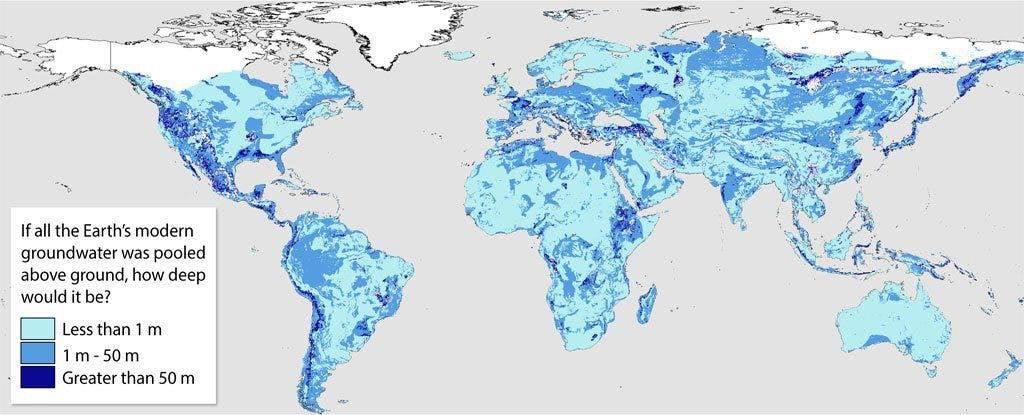A team of North American researchers has analyzed a swarm of data and created the first map that tries to estimate how much water is located beneath the Earth’s surface.

Earth and Water
We tend to think of the water cycle as something that happens above ground, but there’s a lot of water beneath ground – an estimated 23 million cubic kilometers – that’s enough to cover the entire surface in a layer of water about 180 meters thick. In order to come up with this figure, researchers analyzed data from almost a million watersheds, as well as over 40,000 groundwater models; somehow, they managed to integrate all that together and the results can be seen in Nature. They included information on the permeability of rocks and soil, on their porosity, and all that is known about water table gradients. Another important piece of information was the collection of tritium measurements. Tritium is a radioactive isotope of hydrogen that spiked in the atmosphere 50 years ago as a result of thermonuclear bomb tests, and therefore can be used as a trace marker to figure out if the water has been recycled recently.
So how exactly is water stored underground? Well, in most places, the ground is not fully compact, and there are many pores and cracks through which water can slip. It may seem quite small, but you can reach some huge quantities of water through this. But while that may be a lot, only 5.6% of it is actually integrated in the global water cycle – the so-called modern water. This modern water is extractable and usable for human purposes, “It’s the groundwater that is the most quickly renewed – on the scale of human lifetimes,” explained study leader Tom Gleeson from the University of Victoria.
“It’s the groundwater that is the most quickly renewed – on the scale of human lifetimes,” explained study leader Tom Gleeson from the University of Victoria. And yet this modern groundwater is also the most sensitive to climate change and to human contamination. So, it’s a vital resource that we need to manage better.”
The tap might run out
This raises new concerns about global water reserves, which have been dipping worryingly in recent years; almost a third of the global population, over 2 billion people rely strictly on groundwater for drinking water and growing crops. These resources are also most vulnerable to over-usage. Water is most definitely not an infinite resource.
Writing Nature Geoscience, Ying Fan, from Rutgers University, US, commented that “this global view of groundwater will, hopefully, raise awareness that our youngest groundwater resources – those that are the most sensitive to anthropogenic and natural environmental changes – are finite”.
In terms of the map they created, it shows the distribution of this modern groundwater – dark blue shows where it’s quickly renewed, and light blue shows the areas which renew less often, or which are non-renewable at all. If you overlay it on a geographical map, you see that many of the deep blue areas coincide with mountainous areas. Knowing how much water is non renewable is important to estimate how much water we can still use.
“Since we now know how much groundwater is being depleted and how much there is, we will be able to estimate how long until we run out,” he said.






